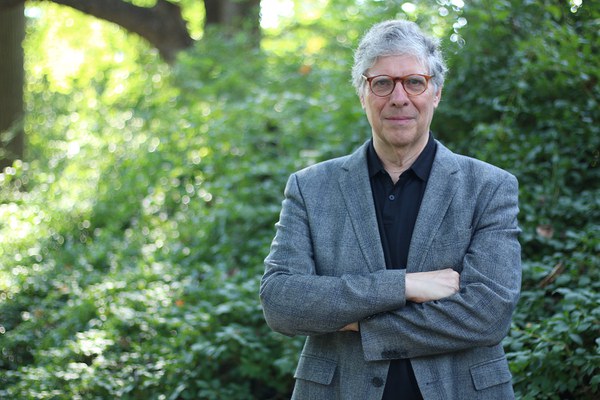Glenn Most, professor of Greek philology at the Scuola Normale Superiore di Pisa, was a visiting scholar from September to October 2018. His talk, “Weeping Heraclitus and Laughing Democritus,” probed the classical origins of a common trope in Renaissance art and offered glimpses of popular culture in antiquity.
Q&A with Glenn Most
How did the idea of contrasting a weeping Heraclitus with a laughing Democritus originate?
Heraclitus and Democritus are two famous pre-Socratic philosophers. Particularly in Dutch paintings and engravings from the 16th to the 18th century, there’s a very strong contrast between a laughing Democritus and a weeping Heraclitus as two possible philosophical attitudes to human misfortunes. Either you can weep at what people do to themselves, or you can laugh at what they do to themselves. Some of the images show Democritus making fun of Heraclitus, looking at us and encouraging a kind of complicity between us and him in scorning the excessive sadness of Heraclitus.
And I asked where this came from, because in ancient texts there is an opposition between weeping Heraclitus and laughing Democritus—but never does Democritus make fun of Heraclitus. Furthermore, Heraclitus is never weeping except when he’s contrasted with Democritus. When he’s not contrasted with Democritus, he’s always angry. It’s hard to see how he could have been thought to be weeping.
What I suggest, then, is that you can’t understand this antithesis if you start out from Heraclitus and Democritus. You have to start out instead from weeping and laughing. And as soon as you do that, you see that what it’s really about is tragedy versus comedy. These two complimentary dramatic moods got exemplified in a weeping philosopher and a laughing philosopher.
This is a case of odd reception of ancient thought. I don’t think there’s any such thing as a flat-out wrong reception. There are more and less interesting, impressive, influential, long-lasting interpretations. But there isn’t a true interpretation or a false one. Heraclitus and Democritus remained cultural figures of admiration and respect into the Renaissance and beyond, thousands of years after their time. People didn’t know very much about them, so they could be used as stereotypes. In the Greco-Roman classical tradition, certain authors and other figures became heroic—not just philosophers but Alexander the Great, Caesar, Cicero, Virgil. These figures remained in the public consciousness, and people used them as a kind of shorthand for complicated ideologies on all kinds of issues. That’s not true of all classical traditions, that people tended to focus on individuals like this, but it is true of some.
Why is considering many classical traditions important for scholarship?
When I began studying, not that many people worked on what they called “the classical tradition,” which was simply Greek and Latin antiquity. One of the things that has changed over the past 50 years is that the classical tradition has become a very widespread object of scholarship. But as scholars have illuminated various aspects of the Greco-Roman classical tradition, we have come to understand that it’s only one of a number of classical traditions that span the globe, from Japan through China, India, Persia, Hebrew, Arabic, Egyptian, Turkic, Greek, and Latin, all the way to the New World, where there’s a Mayan classical tradition.
You only understand what makes a tradition classical if you can compare it to other classical traditions. If you don’t, then you end up saying, “Of course there’s a classical tradition for Greco-Roman civilization. It’s such a wonderful and rich culture that it was natural for people to want to use it.” But that’s not an explanation that gets very far. It’s better to try to be not evaluative but analytic. And the only way to be analytic with something like a classical tradition is to be comparative.
What does your work reveal about popular culture in ancient Greco-Roman civilization?
It’s very hard to find out about popular culture from antiquity, because there wasn’t Twitter, or Facebook, or Instagram. We only have a tiny, tiny fragment of all the discourse produced in antiquity. Most of the discourse was oral, and that’s gone forever. We have really almost no trash culture from antiquity.
What we have, with the exception of a few unusual kinds of documents like papyrus letters or graffiti, are things that were produced by intellectuals. If they write something down, they think about what they’re saying, and it’s usually very complicated. It’s not always as complicated as Aristotle, but it’s usually more complicated than a graffito.
But there’s something very crude about the opposition between Heraclitus and Democritus. It isn’t very complicated. And I think that the opposition just existed in popular culture. People talked about it, or they wrote about it in things we don’t have anymore. So if you can get a sense of ancient popular culture indirectly or through traces, that’s always interesting.
Julia Ostmann is Postgraduate Writing and Reporting Fellow at Dumbarton Oaks. Photo by Elizabeth Muñoz Huber, Postgraduate Digital Media Fellow.

